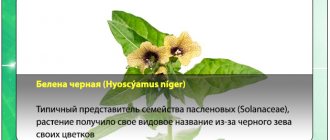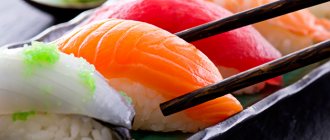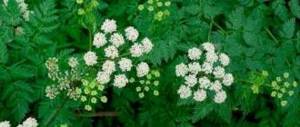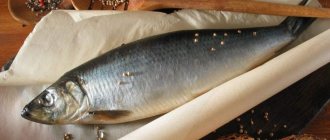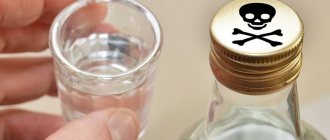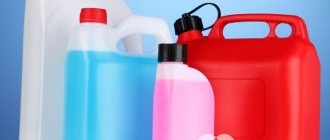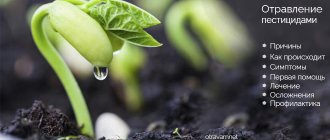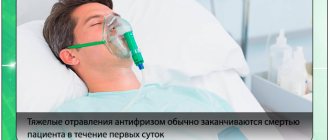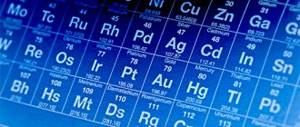With the arrival of spring, life begins to be in full swing at playgrounds. Kids with shovels and buckets firmly occupied the sandboxes, and mothers and grandmothers occupied cozy benches. As soon as the adults are distracted for a moment, the baby is already pulling a red berry into his mouth, which, upon closer examination, turns out to be the poisonous fruit of the lily of the valley. The situation when a child is poisoned by a poisonous plant occurs more often in the warm season. Parents should know everything about the symptoms of dangerous intoxication and the first aid they can provide to their baby.
Henbane black
Some poisonous plants synthesize biologically active compounds - alkaloids. They are used as medicines in strictly defined doses. Such a plant is henbane, which has been used to treat patients since ancient times. But in large doses, henbane can cause poisoning.
Henbane is a herbaceous plant of the nightshade family, 30-60 cm high. The stem is straight, pubescent with soft glandular hairs. The leaves are alternate, elongated-opal, notched-toothed. The basal leaves are petiolate. The flowers are collected on the tops of the stems, are large and have a dirty yellow corolla with dark purple veins. The fruit is a capsule with small brownish-gray seeds.
https://www.youtube.com/watch?v=Y8EcH803DyM
Henbane grows in weedy places, in vegetable gardens, orchards, and roadsides. Wild plants are not harvested for medicinal purposes. All parts of the plant contain poisonous alkaloids of the atropine group. The seeds also contain a bitter glycoside, resins, and fatty oils. It is the seeds, which taste good and resemble poppy seeds, that most often cause poisoning.
The first signs of poisoning are dilated pupils, dizziness, redness of the face, excessive agitation, accompanied by delirium and hallucinations.
Cardiovascular herbs
The toxic effect of these plants is due to the content of cardiac glycosides, which are used in safe doses by pharmacology for the production of drugs. Medicines increase the force of heart contractions while the myocardium is weakened. But in case of overdose, they cause ventricular flutter and disrupt the passage of impulses through the conduction system of the heart.
Oleander
Poisoning can occur through self-medication or accidental chewing of an oleander leaf. The clinical picture resembles an overdose of digoxin, produced from foxglove woolly. After a few hours, symptoms appear:
- nausea;
- vomit;
- diarrhea;
- supraventricular tachycardia;
- slowing of atrioventricular conduction;
- depression of consciousness up to coma;
- in severe cases, acute cardiovascular failure develops.
Intoxication lasts 3–6 days. Oleander infusion greatly lowers blood pressure. Poisoning is not always treatable, even in the intensive care unit. The patient needs to be urgently taken to the hospital.
Lily of the valley
Poisoning occurs in children when eating beautiful red berries or in those who like to self-medicate. Intoxication develops with an overdose of lily of the valley tincture. The poison of flowers and berries, including dried ones, is a cardiac glycoside - convallate toxin. The active substance has a toxic effect on the heart muscle, disrupts atrioventricular conduction, depresses the nervous system, and affects the kidneys. Signs of plant poisoning:
- severe weakness;
- epigastric pain;
- severe nausea;
- uncontrollable vomiting;
- decreased heart rate;
- hypertension followed by hypotension;
- hallucinations.
If you suspect lily of the valley poisoning, immediately call an ambulance. The victim is given a saline laxative (magnesium sulfate) and 10 tablets of crushed activated carbon. You should not lavage the stomach, since vomiting will increase the severity of atrioventricular block.
If help is not provided, the patient dies from cardiogenic shock.
Specific actions
Most often, the organs of the cardiovascular system are the first to be targeted by plant toxins. The symptoms are especially pronounced if intoxication has occurred due to lily of the valley, foxglove or common oleander.
All this leads to the patient almost instantly starting to:
- vomiting and nausea;
- disturbances in the functioning of the heart rhythm;
- a sharp drop in blood pressure, leading to a feeling of lethargy;
- convulsions and even cyanosis.
If it is impossible to provide first aid on time, the person may lose consciousness. In this case, gastric lavage, which is mandatory in such situations, is strictly prohibited. This can cause vomit to block the respiratory system and cause suffocation.
Separately, in case of poisoning, disturbances in the conduction rhythm of the heart muscle are distinguished. So, in case of high poisoning, tachycardia and a subsequent decrease in blood pressure are possible.
In case of particularly severe intoxication, involving a huge dosage, the following occurs:
- collapse;
- conduction disorders in nerves and muscle fibers;
- dilated pupils;
- hearing and vision problems;
- unexplained agitation and irregular breathing rhythm.
In this situation, gastric lavage should be carried out through a tube in order to achieve high efficiency of the procedure. It is carried out in a hospital setting under the supervision of specialists.
The skin is no less susceptible to the negative effects of plant poisons. The development of itching, redness and burning occurs in cases where poisonous pollen or plant sap gets on the skin.
Most often, patients suffer from “acquaintance” with hogweed or plants from the ranunculaceae group. To save yourself from the harmful influence of these plants and others similar in their spectrum of action, you need to:
- wash the affected area of skin with plain water;
- treat the skin with a solution of methylene blue;
- apply a bandage with hydrocartisone ointment.
And immediately after these manipulations you should go to the nearest hospital. There they will conduct a more detailed diagnosis, and a specialized doctor will prescribe a full course of treatment.
But most often, in case of poisoning, the digestive tract organs are at particular risk. This ends with the rapid development of gastroenteritis, as evidenced by the development of:
- nausea,
- vomiting,
- burning sensation in the mouth and esophagus,
- pain syndrome in the abdominal area,
- general dehydration,
- and the appearance of blood in the stool.
In addition to standard measures of assistance, such as drinking plenty of fluids and washing the stomach, the patient needs to be given medications with an enveloping effect.
If you suspect or know for sure that your baby has eaten a poisonous plant, then your actions should include two important points; urgently calling an ambulance and providing immediate first aid independently.
1. Calm down, no matter how difficult it may be. The health and sometimes the life of the baby depends on your actions. You must be collected and confident in your actions. It’s good if there is another adult next to you who can call an ambulance while you are taking care of the child. You can take your baby to the hospital in your own transport, sometimes it’s faster.
Don't delay visiting the doctor. Some parents find the hidden period reassuring. They say the child ate a poisonous plant. But he doesn’t feel sick, his stool hasn’t changed, which means everything is fine. It's a delusion! After a while, the baby will feel ill, and precious minutes when it was necessary to cleanse the body will be missed!
Remember the rule - if a child has eaten a poisonous plant in any, even the most minimal, quantity, he must be examined by a doctor
- If the child can tell you, find out from him when and what he ate, what color the berries were, what the plant looked like and how much he swallowed. Questions must be asked quickly; every minute counts.
- While asking your child questions, quickly examine his mouth. You will be able to see the remains of the plant. They need to be removed as quickly as possible. From the remains it is sometimes possible to determine what type of poisonous grass or berry it is.
- To help the baby before the ambulance arrives, you need to try to cleanse the baby’s body of poison.
At the same time, do a gastric lavage and a cleansing enema.
Human poisoning can be caused by plants that inhibit brain activity. The substances contained in them are able to penetrate the blood-brain barrier. Let's look at the most common herbs with neurotoxic properties.
Veh poisonous
In autumn and early spring, the rhizomes of the poisonous plant (hemlock) accumulate a neurotoxic poison - cicutoxin. Poisoning often occurs in children due to the similarity of the plant's leaves to carrot foliage. The smell of the milestone also resembles that of carrots, and the root has a radish taste. The whole plant is poisonous, but especially its root part. For intoxication, it is enough to eat 50 mg of rhizome per 1 kg of person’s weight. Poisoning manifests itself after 1.5–2 hours with the following symptoms:
- vomit;
- stitching pains throughout the abdomen;
- loose stools;
- hypersalivation (salivation);
- dilated pupils;
- convulsions;
- loss of consciousness is possible.
After cleansing the stomach, a sorbent, such as charcoal, and a laxative are given. In the toxicology department of the hospital, the victim is given a saline laxative (magnesium sulfate), and for convulsions - Diazepam.
Hemlock spotted
The plant, like Vekh, belongs to the Umbrella family. Reaches a height of 60 to 180 cm. Hemlock contains the alkaloid coniine and the toxic substance cicutoxin.
Homeopaths use hemlock as a sedative and also for malignant tumors. Poisoning occurs when the medicine is prepared incorrectly. Exceeding the dose in mild cases causes nausea and vomiting.
In case of severe intoxication, the following symptoms appear:
- dizziness;
- cardiopalmus;
- dyspnea;
- difficulty swallowing;
- increasing muscle weakness leading to paralysis;
- loss of consciousness:
- heart failure.
In case of poisoning, call an emergency team. After cleansing the stomach, the victim is offered 5-6 sorbent tablets (activated carbon) in 1 glass of water. In the toxicology department, if breathing stops, the patient is connected to a ventilator (artificial lung ventilation). Intensive therapy with cardiac and anticonvulsants is carried out.
Datura
This plant with beautiful flowers belongs to the nightshade family. People call it the devil's grass, drunken grass, crazy grass. Since ancient times it has been known for its toxic properties. Datura vulgaris contains the alkaloids atropine, hyoscyamine and scopolamine. In small doses it has a therapeutic effect, in large doses it has a neurotoxic effect. Poisoning occurs in drug addicts when smoking leaves or eating seeds to obtain euphoria. Children may also accidentally eat the seeds.
Symptoms of dope poisoning:
- dilated pupils;
- dry mouth;
- increased heart rate;
- convulsions;
- atropine psychosis (mental and motor agitation);
- swallowing disorder;
- difficulty speaking;
- hypertension followed by hypotension.
Mental disorder manifests itself in the form of visual and auditory hallucinations, inability to distinguish fantasies from reality, and aggressive behavior. Without assistance, cardiac arrest and paralysis of the respiratory center may occur, resulting in death.
Before the doctors arrive, rinse the patient’s stomach with salted water at the rate of 1 tbsp. l. salt per 1 liter of water. You can use a pale pink solution of potassium permanganate. After this, give enterosorbent (5-6 tablets of activated carbon, shaken in 1 glass of water).
At the hospital, the antidote Proserin is administered. If the patient behaves violently, psychosis is stopped. In case of respiratory failure, they are transferred to artificial respiration.
Aconite
Perennial aconite, or fighter, contains poison - the alkaloid aconitine, which has a neurotoxic effect. Signs of poisoning by a poisonous plant of the buttercup family:
- vomiting and nausea, salivation;
- a feeling of pins and needles crawling all over the body (paresthesia);
- numbness of fingers and toes;
- facial muscle spasms;
- constriction of the pupils, lacrimation;
- dyspnea;
- sharp pain in the abdomen and chest;
- tachycardia, increased blood pressure;
- mental and motor excitement;
- pronounced fear of death.
Further, the patient's condition worsens. Blood pressure drops, the pulse becomes rare, the skin loses sensitivity. In this case, the patient is conscious. In the absence of help, death occurs from cardiac arrest or paralysis of the respiratory center.
The victim's stomach must be washed. Then any sorbent is given (Smecta, Polyphepan, Polysorb or activated carbon). In a hospital setting, detoxification and symptomatic treatment are carried out. Glucose solution, saline solutions, Novocainamide, etc. are infused intravenously.
The toxic effect of these plants is due to the content of cardiac glycosides, which are used in safe doses by pharmacology for the production of drugs. Medicines increase the force of heart contractions while the myocardium is weakened. But in case of overdose, they cause ventricular flutter and disrupt the passage of impulses through the conduction system of the heart.
Oleander
Poisoning can occur through self-medication or accidental chewing of an oleander leaf. The clinical picture resembles an overdose of digoxin, produced from foxglove woolly. After a few hours, symptoms appear:
- nausea;
- vomit;
- diarrhea;
- supraventricular tachycardia;
- slowing of atrioventricular conduction;
- depression of consciousness up to coma;
- in severe cases, acute cardiovascular failure develops.
Intoxication lasts 3–6 days. Oleander infusion greatly lowers blood pressure. Poisoning is not always treatable, even in the intensive care unit. The patient needs to be urgently taken to the hospital.
Lily of the valley
Poisoning occurs in children when eating beautiful red berries or in those who like to self-medicate. Intoxication develops with an overdose of lily of the valley tincture. The poison of flowers and berries, including dried ones, is a cardiac glycoside - convallate toxin. The active substance has a toxic effect on the heart muscle, disrupts atrioventricular conduction, depresses the nervous system, and affects the kidneys. Signs of plant poisoning:
- severe weakness;
- epigastric pain;
- severe nausea;
- uncontrollable vomiting;
- decreased heart rate;
- hypertension followed by hypotension;
- hallucinations.
General symptoms
This is what the skin looks like after contact with hogweed
All clinical manifestations can be divided into several groups depending on the nature and location:
|
|
|
|
|
|
|
|
IMPORTANT! Each plant “acts” in its own way, affecting several body systems at once or only one, and some are even more selective: they affect only one organ - the eyes, liver, kidneys. Thus, if the liver is damaged, there is pain in the right hypochondrium and the appearance of jaundice, and if the poison gets into the eyes, visual perception is disrupted, which is accompanied by unpleasant sensations.
Veh poisonous
The most poisonous plant that is found in the Non-Black Earth Zone is the poisonous hemlock, or omega water hemlock. This is a perennial herbaceous plant from the Umbelliferae family with a smooth, branched stem up to 1.5 m high. The leaves are twice or thrice pinnate, with narrow-lanceolate, sharply serrate lobes. The flowers are white, small, collected in a complex umbrella, the rhizome is large, short, resembles rutabaga or turnip in appearance, but unlike them, on the section of the rhizome of the poisonous vek, there are partitions that form cavities. The roots are succulent, up to 4-5 mm thick. Rhizomes and roots have a sweetish taste.
Poisonous weed grows in wet and damp meadows, along the banks of swampy rivers, ditches, streams, the outskirts of swamps, and even in water. All parts of the plant are poisonous. The toxic properties are retained even in dried form. Rhizomes, which are especially toxic in spring, pose a great danger to humans and animals. They contain the toxic substance cicutotoxin.
After parts of the plant, especially the rhizome, enter the human body, poisoning quickly develops with the following symptoms: a sweetish, then bitter taste in the mouth, abdominal pain, salivation, vomiting, respiratory and circulatory disorders, delirium, convulsions. Death may occur from respiratory arrest as a result of paralysis of the respiratory center.
Treatment
Therapy should begin as soon as you notice signs of an eating disorder in your child. At the same time, call a doctor at home. Only a doctor can decide whether treatment at home is possible or whether the baby requires urgent hospitalization.
The most important thing is to compensate for the salt and fluid that the body has lost during this time before the doctor arrives. To do this, give your baby water. Drinking should be fractional and partial - one teaspoon or tablespoon every five to ten minutes. It is best to give your child fruit juice, compote, a five percent glucose solution, tea or Regidron saline-glucose solution.
As soon as diarrhea begins, use enterosorbents. These can be the drugs “Polifepan”, “Smecta”, “Microsorb”. When you find greens, blood or mucus in the patient’s stool, be sure to inform the doctor, then the patient will be prescribed antibiotics.
If the doctor decides to leave the baby at home, use a gentle diet when the child gets better and wants to eat. In most situations, it is recommended to give kefir, rice porridge with water, crackers, mashed potatoes without butter and milk, and pureed vegetarian soups for the first time after poisoning. As a dessert, you can offer a baked apple. You need to eat little by little, but often, at short intervals.
In case of mushroom poisoning, you cannot do without an ambulance. As a last resort, take the child to the nearest hospital yourself. Botulism is treated only in the infectious diseases department. As a therapy there, the patient will be administered an anti-botulinum serum, which effectively neutralizes toxins.
In case of plant poisoning, the poison in the body should be eliminated or its toxicity reduced with the help of an antidote. It is important to take all possible first aid measures for the child even before the doctor arrives.
In any case, regardless of what caused the poisoning, you need to induce vomiting so that the body gets rid of harmful toxins. This should be done by irritating the root of the tongue or pharynx.
Plants that cause food poisoning
This type of intoxication most often occurs in children who are attracted to the bright colors of flowers and berries. Many of them are known as wolfberries. All of them irritate the stomach and intestines. Compared to other toxic herbs, poisoning occurs in a relatively mild form.
Crow's eye
The small herbaceous plant, popularly known as crowberry, cross grass or bearberry, is notable for its fruits, which are similar to blueberries or blueberries. Only one berry ripens on each bush. All parts of the raven's eye are poisonous; they contain flavonoids, coumarins and toxic substances - paridin, paristifin.
- diarrhea followed by vomiting and nausea;
- stitching pain in the abdomen;
- heart rhythm disturbance;
- difficulty swallowing, burning in the mouth;
- headaches, dizziness;
- convulsions are possible.
The greatest danger of the plant is its negative effect on the functioning of the heart muscle. If similar signs are noticed, you need to call an ambulance. Read more about raven eye poisoning here.
It is a shrub that grows in forests. Its decorative variety is found in garden plots. The berries, grown together in pairs, resemble red currants. They, like the raven's eye, are popularly called wolf berries. Honeysuckle fruits are inedible, but not poisonous. They have laxative, diuretic, emetic and antiseptic effects
Out of curiosity, children can try honeysuckle berries. Signs of poisoning:
- colic in the abdomen;
- frequent vomiting;
- diarrhea.
Poisoning occurs under the influence of a toxic substance - xylostein. Intestinal upset from honeysuckle is not fatal. Pain in the epigastric region continues for up to 2-3 days, then goes away on its own. However, if your child experiences diarrhea or vomiting, you should consult a doctor.
Briefly about the reasons
Childhood curiosity can lead to tragedy
Most of these plants serve as raw materials for the production of medicines, and some are successfully used in folk practice:
- It is home folk self-medication that is the main cause of all poisonings with poisonous fruits and herbs. Believing that “natural” means “safe,” people do not follow dosages, neglect the characteristics of specific plants, invent new recipes and willingly share them with friends, relatives and strangers, putting other people’s lives at risk.
- In second place is curiosity. Most often, children who are attracted to a beautiful berry or flower, and tourists who use unfamiliar fruits and plants as food and treats suffer from this.
- And in third place is chance.
Folk remedies are not always beneficial
Some statistics. Every year, up to 10% of all people seeking medical help for poisoning are people who have been in contact with plant poisons. Of these, more than 80% are children under the age of 6–8 years. Almost 90% of all cases are due to ingestion of poison, leaving only 5-10% due to exposure to toxins on the skin or eyes.
Wolf's Bast
A strongly branched shrub from the berry family. Its branches are twig-like, with gray bark covered with small brown spots. The leaves are alternate, oblong-lanceolate, collected at the ends of the branches. The leaves are bluish-green above, bluish below. The flowers are four-petalled, pink or white, fragrant, sitting on the sides of the branches in the axils of the leaves. The fruit is a juicy berry, bright red, sometimes yellow; grow directly on the stem.
All parts of the plant are poisonous. They contain a toxic substance - daphnin. The bark and sap of the plant, as well as the berries, which are attractive with their bright colors, are especially poisonous. It is even dangerous to touch the plant; under no circumstances should you touch it with your hands, since contact with the plant on human skin causes irritation, inflammation, blisters and long-term non-healing ulcers.
Peculiarities
When a child is poisoned, you need to strictly follow a certain algorithm in order to provide timely and effective assistance. Food poisoning is usually caused by an intestinal infection. It includes a large group of diseases caused by viruses and bacteria. The most common infections are salmonellosis, dysentery, campylobacteriosis, escherichiosis, and yersiniosis. Intestinal infections affect patients regardless of age. Often you have to deal with the fact that a small child has been poisoned.
In most cases, in children, the poisoning can be caused by poisonous mushrooms, which retain dangerous properties even after all kinds of processing methods. In addition, poisonous plants provoke intoxication, some even when in contact with them or their juice.
Many toxic substances have antidotes that neutralize the negative effects. They can be ethyl alcohol or vegetable oil, which can be found at home.
With the arrival of spring, life begins to be in full swing at playgrounds. Kids with shovels and buckets firmly occupied the sandboxes, and mothers and grandmothers occupied cozy benches. As soon as the adults are distracted for a moment, the baby is already pulling a red berry into his mouth, which, upon closer examination, turns out to be the poisonous fruit of the lily of the valley. The situation when a child is poisoned by a poisonous plant occurs more often in the warm season . Parents should know everything about the symptoms of dangerous intoxication and the first aid they can provide to their baby.
Crow's eye
A perennial herbaceous plant from the lily family. The stem is erect, 20-30 cm high and has four obovate leaves arranged crosswise. The rhizome is creeping, long, thin. A greenish-yellow flower grows at the top of the stem. Blooms in May-June. From the flower in July-August a fruit is formed - a large black-blue berry.
The whole plant is very poisonous, especially the spherical berries contain a lot of poison. Poisoning with berries causes nausea, vomiting, and abdominal pain.
Dieffenbachia - a poisonous houseplant
This ornamental plant with beautiful wide leaves is kept at home for decoration. Dieffenbachia juice is poisonous. It contains oxalic acid, calcium oxalate, essential oils and alkaloids. Upon contact with the mucous membrane of the mouth, swelling of the lips and tongue, irritation of the throat, and even suffocation develop. Contact of juice with the skin leads to chemical burns, redness, and burning. An allergic reaction is manifested by general symptoms:
- difficulty swallowing;
- salivation;
- vomit;
- diarrhea;
- loss of voice.
Poisoning occurs accidentally in children after chewing the leaves. Adults get skin damage when caring for a flower without gloves. It is very dangerous to get Dieffenbachia juice from unwashed hands into your eyes.
If juice gets on your skin, immediately rinse the affected area with running water. If a child chews a leaf, you should immediately call an ambulance. Children do not need to rinse the stomach on their own: this can cause increased burns to the mucous membranes.
Low toxic plants
Eating low-toxic plants is not life-threatening, but leads to a number of unpleasant consequences: digestive system upset, diarrhea, weakness, vomiting, trembling. Low-toxic plants include representatives of the amaryllis family, which contain lycorine or other toxic alkaloids: amaryllis, hymenocallis, hemanthus, hippeastrum, zephyranthes, crinum, clivia, nerine, eucharis. Many other plants are also low-toxic: aloe, geranium, gardenia, dracaena, Kalanchoe calamondin, cordilina, strelitzia, yucca. However, there are many beautiful house plants that do not pose any health hazard: orchids, gloxinias and other representatives of the Gesneriaceae family, Usambara violets, hibiscus, various types of succulents. The listed plants can be safely used to create a home collection.
Cheremitsa Lobelya
A tall herbaceous perennial plant from the lily family, up to 2 m high. The stem is thick and straight. The leaves are alternate, elliptical, entire and glabrous. The flowers are greenish, inconspicuous, forming a long inflorescence - a panicle - at the top of the plant. Blooms in June-August. All parts of hellebore contain poisonous alkaloids.
Hellebore irritates the mucous membranes of the nose, mouth, and throat, causing severe sneezing. In case of poisoning, a burning sensation in the mouth, salivation, vomiting, abdominal pain, diarrhea, and respiratory depression are observed.
First aid for poisoning by poisonous plants
In case of poisoning by plant poisons, it is necessary to provide the victim with emergency first aid:
- First of all, you need to call a medical team.
- Provide the person with complete rest and access to air.
- Cleanse (lavage) the stomach. The easiest way is to drink plenty of water (preferably at room temperature). Five glasses is considered optimal. After which you must immediately induce vomiting. The procedure is repeated several times until only clean water begins to come out. After this, you can drink a couple of sips of non-hot tea without sugar.
- You can also take enterosorbent at home - activated carbon or Enterosgel.
- If you have a high temperature, take an antipyretic drug - Paracetamol or Ibuprofen.
In case of burns, therapy for the victim can be performed at home. If the skin is damaged, it is necessary to treat it with a solution of Furacilin or potassium permanganate. In addition, the person must ensure that the wound is protected from the sun's rays (at least for three days). For burns, antihistamines are prescribed - Zodak, Claretin or Suprastin. They reduce itching and relieve allergies. It is recommended to apply anti-burn medications (Panthenol or Zinc ointment) to the wounds.
To prevent dehydration caused by indigestion and vomiting, use Regidron or Hydrolyte. They replenish fluid loss and restore the balance of acid and alkali.
If poison enters the body through the mouth, the medical team administers an antidote and takes the patient to the hospital. If a victim of poison is unable to breathe, he is connected to a special ventilator. Doctors also provide symptomatic therapy. Tannin is used to relieve the patient from vomiting, diarrhea and weakness.
First aid measures for poisoning are identical. The main event at home involves removing toxic substances from the digestive system. At the same time, call an ambulance. In some cases, it will be necessary to administer an antidote and purify the blood.
First aid:
- Gastric lavage with clean water or lightly brewed tea.
- Taking sorbents - Smecta, Polyphepan, activated carbon, Polysorb, etc.
If poisoning by poisonous plants does occur, then first of all it is necessary to urgently remove the poison from the body and slow down its absorption. First of all, you need to induce vomiting by irritating the root of the tongue and give the victim a large amount (4-5 glasses) of warm salted water inside. Also recommended for the purpose of oxidizing toxic products is a solution of potassium permanganate for gastric lavage.
Reducing the absorption of poisons is facilitated by taking a suspension of activated carbon - carbolene. To do this, several tablets are crushed, mixed with water and given to the victim to drink. It is advisable to do a cleansing enema. If you touch a poisonous plant with your hands or body, wash the affected area several times with soap and water or a solution of potassium permanganate. The victim should be immediately taken to a medical facility to provide qualified medical care.
Article provided by the site “In the World of Herbs”
First of all, you need to cleanse the body of toxins from the poisonous plant. The sooner you do this, the better the prognosis. The standard form of first aid for poisoning is gastric lavage, which must be done correctly and carefully so as not to worsen the situation. It is important to call an ambulance in time, then lay the victim on a flat surface and cover with a blanket.
If the juice of a poisonous plant gets on your skin, you need to wash the area with soap and water, lubricate it with a nourishing cream (you can use butter), and apply a cold compress on top.
For treatment, victims are hospitalized in the gastroenterology department, and if the case is too severe, then in the toxicology department. The course and treatment regimen depend on the severity of the lesion. Generally, the duration of therapy ranges from a week to one month. Patients are prescribed magnesium droppers, activated charcoal and laxatives. To get rid of seizures, use a barbamyl solution.
A strict diet is required.
Barbamil
Thus, avoiding poisoning from a poisonous plant is quite simple; it is important to know one clear and smart rule: if you don’t know, don’t touch. It’s better not to risk your health and life, so take care of yourself and your loved ones.
First aid
Help for the victim is provided on an emergency basis. The main task when the first signs of poisoning appear is to stop further entry of poison into the body.
The rapid development of clinical signs of poisoning requires immediate implementation of the following measures:
- Gastric lavage.
- Reception of sorbent.
- Control of breathing and heartbeat.
The victim is given up to 3 liters of water with the addition of potassium permanganate to drink. The solution should be slightly pink in color. Potassium permanganate oxidizes organic compounds, reducing their toxicity. Vomiting can be caused as a reflex by irritating the root of the tongue or the back of the throat. The stomach should be cleaned until clean rinsing water appears.
Activated carbon is used as a sorbent. If convulsions develop, the victim must be protected from damage and the airway must be ensured. It is important to prevent tongue biting by placing any hard object between the teeth.
There are no antidotes for many plant poisons that cause poisoning. Early first aid is an important step on the path to recovery.
How to avoid poisoning from a poisonous plant?
Prevention of intoxication consists of following simple rules:
- do not take homemade tinctures without consulting your doctor;
- strictly adhere to the dosage of medicinal herbal products prescribed by the doctor;
- do not trust your life to dubious doctors;
- Keep an eye on your children while walking in the forest.
You cannot prepare homemade medicines from plants purchased near the metro from strangers.
When using alcoholic tinctures of medicinal herbs, carefully read the instructions included with the package. If you use traditional medicine, consult your doctor first.
